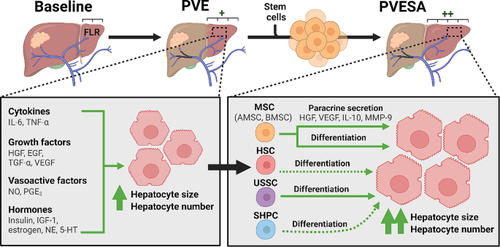Stem Cell Reviews and Reports ( IF 4.8 ) Pub Date : 2024-04-13 , DOI: 10.1007/s12015-024-10719-1 Allan John R. Barcena , Tyler C. Owens , Sophie Melancon , Isias Workeneh , Hop S. Tran Cao , Jean-Nicolas Vauthey , Steven Y. Huang

|
Portal vein embolization with stem cell augmentation (PVESA) is an emerging approach for enhancing the growth of the liver segment that will remain after surgery (i.e., future liver remnant, FLR) in patients with liver cancer. Conventional portal vein embolization (PVE) aims to induce preoperative FLR growth, but it has a risk of failure in patients with underlying liver dysfunction and comorbid illnesses. PVESA combines PVE with stem cell therapy to potentially improve FLR size and function more effectively and efficiently. Various types of stem cells can help improve liver growth by secreting paracrine signals for hepatocyte growth or by transforming into hepatocytes. Mesenchymal stem cells (MSCs), unrestricted somatic stem cells, and small hepatocyte-like progenitor cells have been used to augment liver growth in preclinical animal models, while clinical studies have demonstrated the benefit of CD133 + bone marrow–derived MSCs and hematopoietic stem cells. These investigations have shown that PVESA is generally safe and enhances liver growth after PVE. However, optimizing the selection, collection, and application of stem cells remains crucial to maximize benefits and minimize risks. Additionally, advanced stem cell technologies, such as priming, genetic modification, and extracellular vesicle-based therapy, that could further enhance efficacy outcomes should be evaluated. Despite its potential, PVESA requires more investigations, particularly mechanistic studies that involve orthotopic animal models of liver cancer with concomitant liver injury as well as larger human trials.
中文翻译:

术前干细胞增强门静脉栓塞术 (PVESA) 的当前观点和进展
干细胞增强门静脉栓塞术 (PVESA) 是一种新兴方法,用于增强肝癌患者手术后保留的肝段(即未来肝残余,FLR)的生长。传统的门静脉栓塞(PVE)旨在诱导术前 FLR 生长,但对于患有潜在肝功能障碍和合并症的患者存在失败的风险。 PVESA 将 PVE 与干细胞疗法相结合,有可能更有效地改善 FLR 大小和功能。各种类型的干细胞可以通过分泌促进肝细胞生长的旁分泌信号或转化为肝细胞来帮助改善肝脏生长。间充质干细胞 (MSC)、非限制性成体干细胞和小肝细胞样祖细胞已被用于增强临床前动物模型中的肝脏生长,而临床研究已证明 CD133 + 骨髓来源的 MSC 和造血干细胞的益处。这些研究表明,PVESA 通常是安全的,并且可以促进 PVE 后的肝脏生长。然而,优化干细胞的选择、收集和应用对于最大化效益和最小化风险仍然至关重要。此外,应该评估先进的干细胞技术,例如启动、基因改造和基于细胞外囊泡的治疗,这些技术可以进一步提高疗效。尽管有潜力,PVESA 还需要更多的研究,特别是涉及肝癌原位动物模型并伴有肝损伤的机制研究以及更大规模的人体试验。



























 京公网安备 11010802027423号
京公网安备 11010802027423号